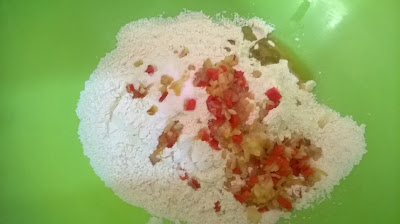Akara in Yoruba and Kose in Hausa, these deep fried bean cakes are enjoyed all over Nigeria. Traditionally they are made from dried black-eyed beans or honey beans, soaked overnight and skins removed. Then they are put through a grinder with onion, salt, tatashe ( a large type of hot pepper) and maybe one or two other ingredients, depending on locality.
Then oil is heated in a large basin and the mixture is dropped in by the spoonful, turned over once or twice and fried until golden brown. When done they are drained on newspaper which does take up the excess oil to a certain extent. Finally wrapped in fresh newspaper the akara are sold to the waiting customer.
For a long time I was racking my brain how to recreate the deliciousness of akara without the process of deep frying, because any food saturated with fat is an absolute taboo for anyone with heart problems, high cholesterol and/or diabetes. So a healthy version was needed, especially since beans are highly recommended for anyone with these conditions.
 |
| Baked akara |
So I tried baking the mix with the addition of baking powder but all I got was a soggy mess. After several attempts I gave up. Then I stumbled on some bread recipes made with bean flour and that triggered a few flashing light bulbs!
This time my experiment turned out to be a winner! Therefore I will share my recipe so that anyone with health concerns can enjoy their akara!
Ingredients:
1 cup bean flour
3/4 cup lukewarm water
3/4 tsp salt
1 tsp dried active yeast plus a pinch of sugar
1 Tbsp regular flour
1 1/2 Tbsp vegetable oil
1 small onion, chopped finely
1 small hot pepper (I used Scotch Bonnet), seeds removed and finely chopped
Other items:
mixing bowl
whisk, wooden spoon
measuring cups and spoons
small jug for the water
muffin tin, greased
saute pan
Method:
Sift the two flours together with the salt into the mixing bowl. Stir yeast and sugar into the water, cover and allow to stand for 5 - 10 minutes.
Meanwhile heat the oil in the saute pan and gently fry the onion and pepper for a few minutes until onion is translucent. Take off the heat and allow to cool.
When just warm pour over the flour mix and stir in. Then add the dissolved yeast and whisk to get rid of any lumps.
Pour into the muffin tin, dividing batter equally, not more than half full for each. Cover with a dishcloth or a sheet of plastic and allow to rise for an hour or two in a warm place. The batter will not rise too much because bean flour does not contain many carbohydrates. The extra flour added will allow the yeast to lighten the batter. When ready the batter will have a spongy, mousse like texture and should have risen by half.
Preheat oven to 180 C - gas mark 4 - for 5 minutes, then place muffin tin on middle shelf and bake for 15 minutes. When a toothpick inserted comes out dry and clean remove from oven and transfer to a cooling rack for a few minutes before serving.
 |
| Bean flour with the fried onion/pepper mix |
 |
| Doubled quantity baked in a different muffin tin |
.






